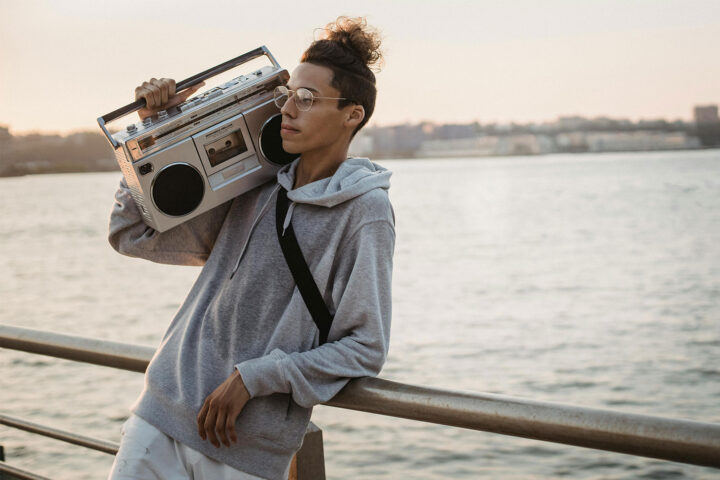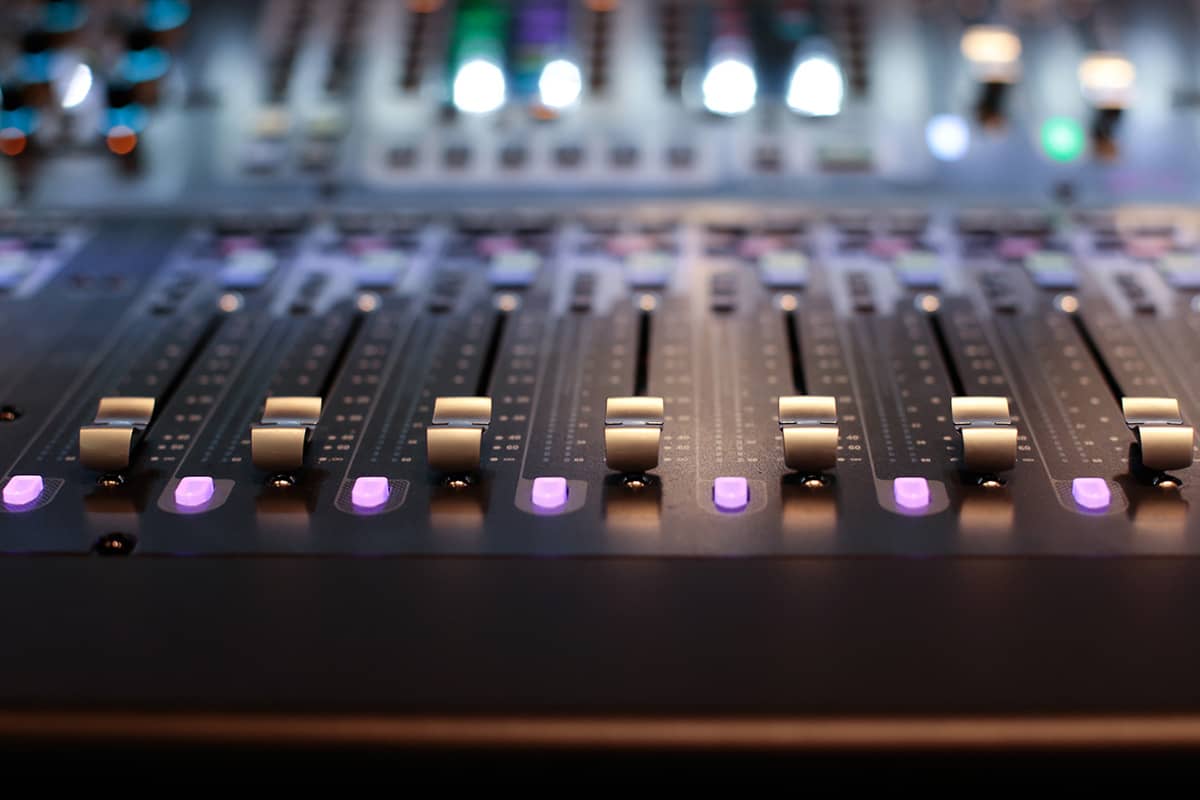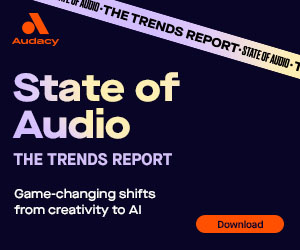Where Will Your Political Ad Dollars Have the Most Impact?
To sway voters during election season, no medium holds more influence than Radio
With just over a month until the 2022 midterm elections, one thing is already abundantly clear – this year’s political ad spending will shatter records.
Nonpartisan intelligence firm AdImpact projects total expenditures on campaign and issue advertising to hit $9.7 billion. That’s over double the $4 billion spent in the 2018 midterms and $700 million dollars more than the historic $9 billion shelled out for the 2020 presidential cycle.
Yet, there’s a conundrum. Despite all the money flowing to the media, voter attention has never been so fragmented. Broadcast television ratings keep dropping. Digital consumption keeps rising. We’re spending more time with connected TV (CTV) and streaming video. But while TV, CTV, and digital duke it out among themselves, one medium rises above the fray.
Radio Stands Apart
Radio pulls in a unique set of voters that the other media can’t deliver. In a $1 million advertising buy divided evenly across the four distribution channels (TV, CTV, Internet, and Radio), nearly half (48%) of voters came from Radio. In comparison, TV and the Internet aren’t even close. They’re tied at 26% each, while fewer than 1 in 5 (19%) were reached by CTV.
What’s more, Radio attracts a pool of people not found on the other three mediums. More than 1-in-3 (37%) of the voters from Radio ads are unique to Radio.1
In fact, throughout the voter decision process, Radio holds the greatest influence among voters and community activists. When the four outlets are compared, Radio is on top for increasing awareness, consideration, and participation throughout the voter journey.1
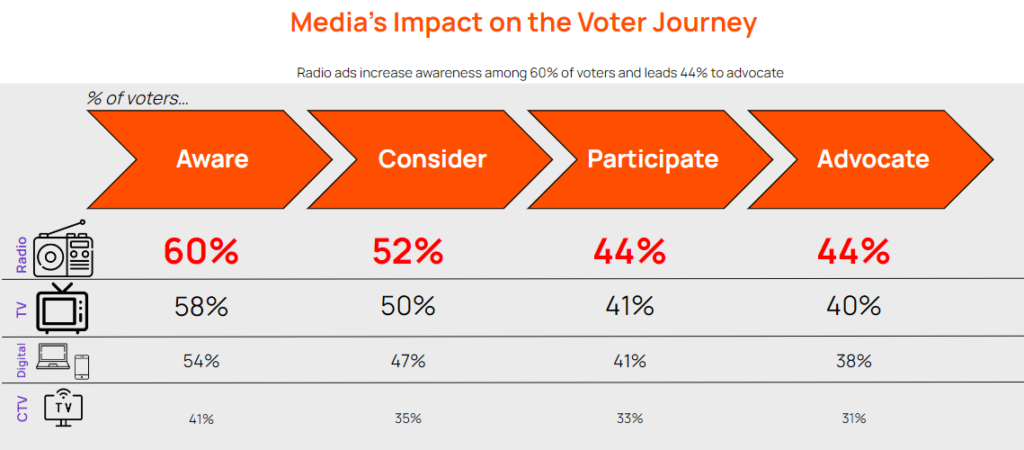
Why does Radio hold so much influence with voters? There are many reasons, but chief among them is believability. More people trust Audio than any other medium. More than two-thirds of respondents trust Audio – and that’s ahead of TV, search and social media.2
Radio Builds Political Brands
Political campaigns like voters to get a visual sense of the candidate, to see her or him in action. Usually, that means creating television or digital video ads. That’s why from now until Election Day, viewers will be inundated with a plethora of television commercials featuring politicians.
It turns out, though, that television, when combined with Radio, performs better than TV alone. Case in point–In last year’s Virginia gubernatorial race, candidate Glenn Youngkin (R) was polling behind the other candidate, Terry McAuliffe (D) at the beginning of the summer. Youngkin then began investing in Audio, while McAuliffe initiated his radio campaign much later… after Labor Day. By then, Youngkin’s favorability among Virginia voters had jumped up 22% and cut the polling deficit in half.
Ultimately, Youngkin overtook McAuliffe. Youngkin’s effective and uncontested use of Audio helped boost his standing with voters and he claimed victory in the Old Dominion state’s Governor’s race.
Better Together
One of the key lessons from the Youngkin campaign was that Radio + TV provided a larger ballot lift (7%) than digital + TV (5%). And among digital, TV, and Audio, it was the “theater of the mind” medium that provided the greatest ballot lift overall.3
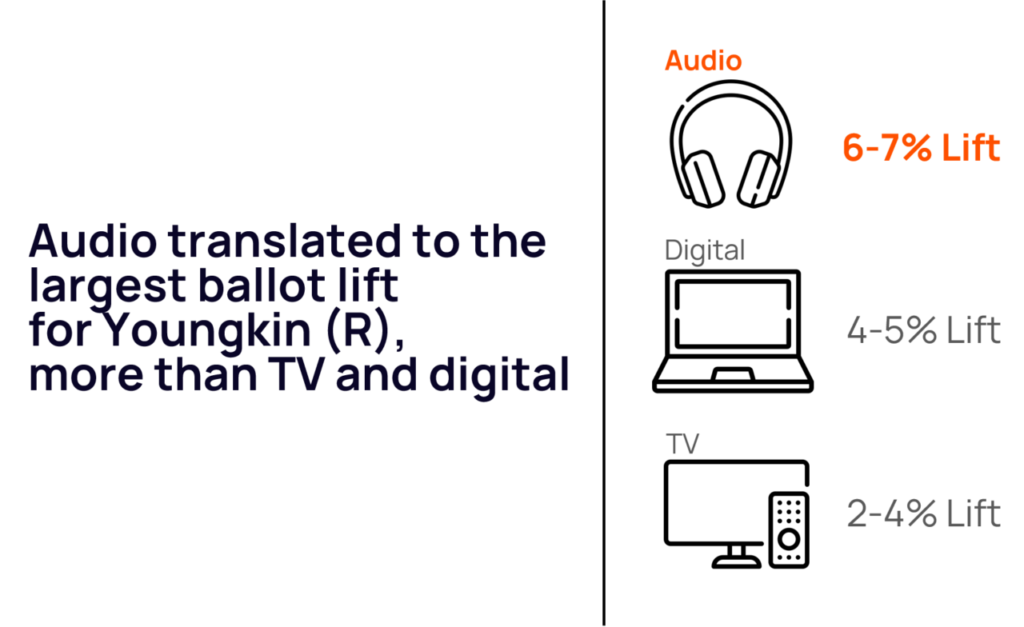
Targeting and Reach
Political operatives understand Radio is excellent in getting out the vote. Campaigns regularly use Radio to target specific demographics and psychographics, such as African American, Hispanic or conservative voters, to make it to their precincts on Election Day.
However, when you utilize Radio earlier in the campaign cycle, candidates benefit from building their brand, and it enhances the TV campaign, if used earlier and more often during an election year. Campaigns embracing TV + Radio are able to achieve incremental unduplicated reach of potential voters, but also enhances the ad recall and memorability of the TV commercials.
Using sophisticated media planning software from Nielsen, we have analyzed dozens of campaigns across the past two cycles, as well as several current campaigns. What we can plainly see is that Radio delivers TV “Unreachables”, and brings significant incremental reach to the table for campaigns.
As we saw in the 2021 Virginia Governor’s race, Radio is a mass reach medium that can help offset audience losses from streaming and time-shifted television viewing.
So while this year’s political advertising spending may be off-the-charts, it doesn’t mean campaign messages have to get lost in all the noise. Creating a balanced broadcast media mix, inclusive of Radio, can have a tremendous impact on a campaign’s outcome.
Want to talk more about reaching your target audience?
Let´s Talk1 Nielsen Commspoint Influence, Planning insights, Channel ranking, Voters and Community Activists US 2022 MRI Simmons data
2 Audacy Audio Amplification: Engaged Impressions, August, 2020

